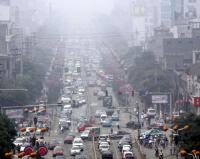Having sped past the U.S. as the world’s leading emitter of greenhouse gases, China has become a despoiler on a scale as monumental as its economic expansion, plundering smaller nations to fuel its own rising tide of consumption.
A New York Times article just after the UN climate-change conference in Indonesia identified China as the pivotal determinant on global warming. Now, the left-leaning Mother Jones magazine has drawn a scathing portrait of a nation that not only leads the world in coal consumption, but also uses more than the next three highest-ranked nations – the U.S., Russia and India – combined, with ominous implications for the planet.
China says that as a poor nation of 1.3-billion people, it is entitled to pollute and spew greenhouse emissions to alleviate poverty. But with its middle class projected to leap from less than 100 million to 700 million by 2020, and with sales of Porsches, Ferraris and Maseratis flourishing in Beijing, that argument is rapidly losing its edge.
No sector better illustrates the vast reach and explosive impact of China’s powerhouse economy than logging, with demand for Chinese-made furniture and other wood products creating social and environmental devastation in the poor countries that supply the wood.
The resulting deforestation dramatically accelerates climate change. Felled trees not only lose their ability to absorb carbon but also release sequestered carbon. Thus, deforestation accounts for 18 percent of world greenhouse gas emissions, eclipsing the global transportation sector’s 14 percent.
Amazingly, staggering deforestation in poor, non-industrial Indonesia places that country third among the world’s emitters, after the China and the U.S.
Among China’s leading wood importers, Thailand and Philippines have already been stripped of their natural forests, while Indonesia and Burma are projected to lose theirs within a decade. Papua New Guinea’s will succumb within 16 years, and the vast forests of the Russian Far East will survive no more than two decades.
Even so, Washington, D.C.-based Forest Trends estimates China’s wood imports will probably double within 10 years, with manufacturers already developing replacement sources in Africa.
South America’s forests are also threatened, but for a different reason: China’s growing consumption of pork and chicken is fed by soybeans grown on newly cleared Amazonian land. By one estimate, 30 percent of the jungle could eventually be transformed into soybean fields.
Until 1998, China logged its own forests. Then Chinese companies began clearcutting other nations’ trees. Since most of the world’s remaining natural forests are protected by law and regulation, deforestation is largely due to illicit logging, and China is the world’s leading importer of illegally logged wood.
Chinese wood purchases have also helped finance armed conflicts by such notorious brigands as Cambodia’s Khmer Rouge, Burma’s military government and Liberia’s Charles Taylor. The UK watchdog Environmental Investigation Agency says, “China is the number one buyer of timber from many of the countries most affected by the scourge of illegal logging.”
The largest timber supplier to China is Russia, where half of all logging is illegal. In Siberia, where pine forests are largely protected unless damaged by fire, loggers bent on exporting to China routinely set the woods ablaze.
It would undoubtedly help to end U.S. and European purchases of products made from illegal clearcutting, as half the tropical wood that enters China is exported as finished goods. Still, some 90 percent of Chinese-manufactured wood products are consumed within China.
This is alarming, because Chinese per-capita consumption of wood products is still far below that of developed countries, and is bound to grow as the middle class expands. China’s per-capita consumption of paper, for example, is now only an eighth of the U.S.’ If it reaches the American rate, suppliers will have to double the world’s annual timber harvest.
As Greenpeace said in a 2006 report, “The world’s forests cannot support either the level of consumption of developed countries, or the aspiration of developing countries to attain a similar level.”
Subscribe to our newsletter
Stay up to date with DeSmog news and alerts






